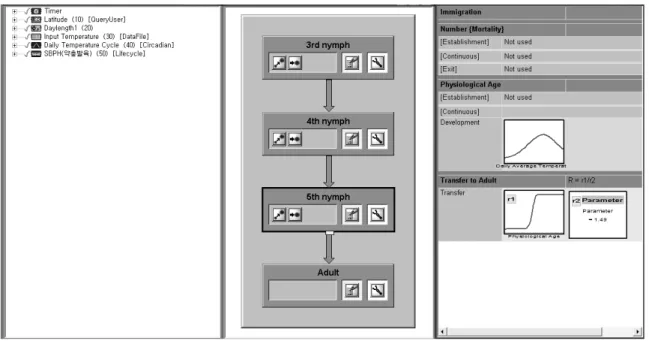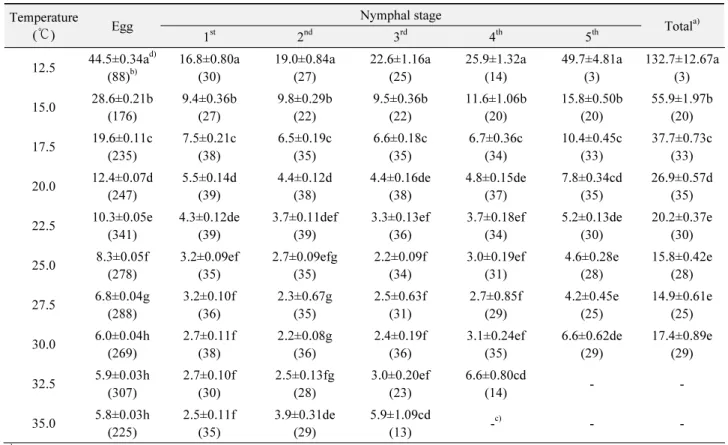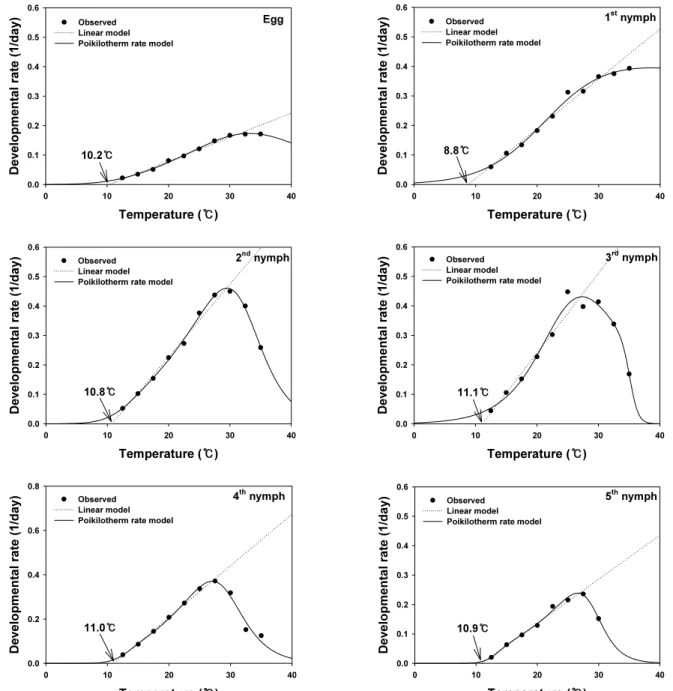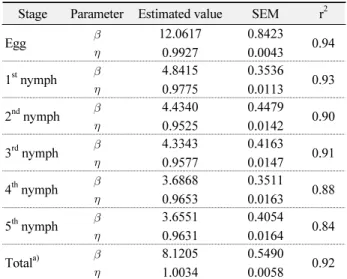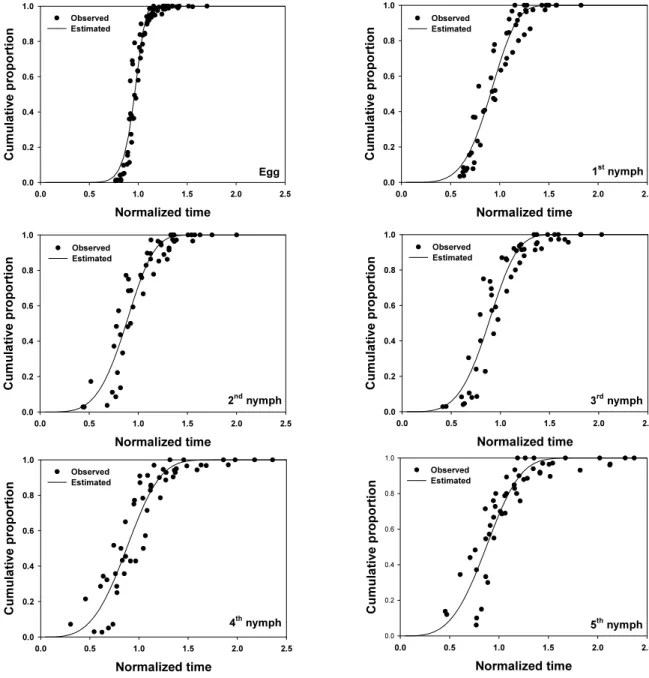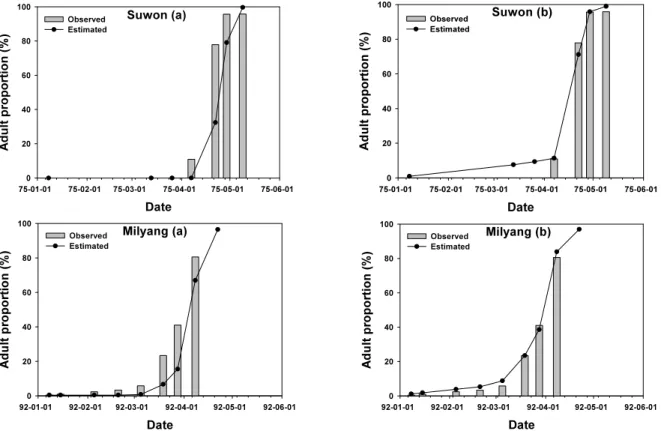KOREAN JOURNAL OF APPLIED ENTOMOLOGY
한응곤지 50(4): 343~352 (2011) ⓒ The Korean Society of Applied Entomology
Kor. J. Appl. Entomol.
DOI: http://dx.doi.org/10.5656/KSAE.2011.10.0.62
애멸구 온도 발육 모델과 월동 개체군의 성충 발생 예측
박창규*ㆍ박홍현ㆍ김광호
국립농업과학원 농업생물부 작물보호과
Temperature-dependent Development Model and Forecasting of Adult Emergence of Overwintered Small Brown Planthopper, Laodelphax
striatellus Fallen, Population
Chang-Gyu Park*, Hong-Hyun Park and Kwang-Ho Kim
Crop Protection Division, Department of Agricultural Biology, National Academy of Agricultural Science, Suwon 441-853, Republic of Korea
ABSTRACT: The developmental period of Laodelphax striatellus Fallen, a vector of rice stripe virus (RSV), was investigated at ten constant temperatures from 12.5 to 35±1 ℃ at 30 to 40% RH, and a photoperiod of 14:10 (L:D) h. Eggs developed successfully at each temperature tested and their developmental time decreased as temperature increased. Egg development was fasted at 35 ℃(5.8 days), and slowest at 12.5 ℃ (44.5 days). Nymphs could not develop to the adult stage at 32.5 or 35℃. The mean total developmental time of nymphal stages at 12.5, 15, 17.5, 20, 22.5, 25, 27.5 and 30℃ were 132.7, 55.9, 37.7, 26.9, 20.2, 15.8, 14.9 and 17.4 days, respectively.
One linear model and four nonlinear models (Briere 1, Lactin 2, Logan 6 and Poikilotherm rate) were used to determine the response of developmental rate to temperature. The lower threshold temperatures of egg and total nymphal stage of L. striatellus were 10.2℃ and 10.7 ℃, respectively. The thermal constants (degree-days) for eggs and nymphs were 122.0 and 238.1DD, respectively. Among the four nonlinear models, the Poikilotherm rate model had the best fit for all developmental stages (r
2=0.98 ∼0.99). The distribution of completion of each development stage was well described by the two-parameter Weibull function (r
2=0.84∼0.94). The emergence rate of L. striatellus adults using DYMEX
®was predicted under the assumption that the physiological age of over-wintered nymphs was 0.2 and that the Poikilotherm rate model was applied to describe temperature-dependent development. The result presented higher predictability than other conditions.
Key words: Laodelphax striatellus, Temperature-dependent development models, Stage emergence model, Forecasting, DYMEX
®초 록: 줄무늬잎마름병을 매개하는 애멸구, Laodelphax striatellus Fallen의 온도에 따른 알 및 약충 발육 기간을 12.5, 15, 17.5, 20, 22.5, 25, 27.5, 30, 32.5, 35±1 ℃의 10개 항온, 14:10 (L:D) h 광, 상대습도 30~40% 조건에서 조사하였다. 알은 모든 온도 조건에서 1령으로 성공적으 로 발육하였으며, 발육기간은 12.5℃에서 44.5일로 가장 길었고 온도가 증가함에 따라 짧아져 35℃에서 5.8일로 가장 짧았다. 약충은 12.5, 15, 17.5, 20, 22.5, 25, 27.5, 30 ℃에서 성충까지 발육 가능하였으며, 각 온도에서 약충 전체 발육기간은 132.7, 55.9, 37.7, 26.9, 20.2, 15.8, 14.9, 17.4일이 소요되었다. 온도와 발육율과의 관계를 설명하기 위해 선형 및 4개의 비선형 (Briere 1, Lactin 2, Logan 6, Poikilotherm rate) 모델 을 사용하여 분석하였다. 선형 모델을 이용하여 추정한 알과 약충 전체기간 발육을 위한 발육영점온도는 각각 10.2℃와 10.7℃였으며 발육에 필 요한 유효적산온도는 각각 122.0, 238.1DD였다. 4가지 비선형 모델 중 Poikilotherm rate 모델이 모든 발육단계에서 온도와 발육율과의 관계 를 가장 잘 설명하였다 (r
2=0.98 ~0.99). 알 및 유충의 발육단계별 발육완료 분포는 two-parameter Weibull 함수를 사용하였으며 모든 발육단 계에서 비교적 높은 상관관계 (r
2=0.84 ~0.94) 값을 보여 양호한 모형 적합성을 보였다. DYMEX
®(version 3.0)를 이용하여 2개 지역에서 애 멸구 월동 개체군의 발육을 추정한 결과 월동 후 개체군의 생리적 연령을 0.2로 가정하고 온도발육 모델로 Poikilotherm rate 모델을 사용하였을 경우 높은 우화시기 예측력을 볼 수 있었다.
검색어: 애멸구 , 온도의존적 발육 모형 , 발육단계별 발육완료 모형 , 예측 , DYMEX
®*Corresponding author: changgpark@korea.kr Received October 7 2011; Revised October 24 2011;
Accepted December 12 2011
애멸구 (Laodelphax striatellus Fallen)는 벼 줄무늬잎마름병 (Rice stripe virus, RSV) 의 매개충으로 우리나라에서는 주로 4 령의 약충 형태로 논둑이나 휴반에서 월동한다 (Hyun et al., 1977). 벼 줄무늬잎마름병은 영남 지역을 중심으로 지역과 연도 에 따라 간헐적으로 남부 지방에서 대발생하여 문제가 된 적이 있었으나(Choi et al., 1974; Chung, 1974), 최근(2001년, 2007 년)에는 강화, 김포, 서천, 부안, 해남 등 서해안을 중심으로 대발 생 (Park et al., 2009)하여 과거와는 전혀 다른 발생 양상을 나타 내고 있으며, 이러한 현상의 원인과 대책 마련에 관한 연구들이 활발하게 진행 중에 있다.
애멸구에 의한 피해는 직접 흡즙에 의한 생육저해나 고사의 경우는 거의 없으며 줄무늬잎마름병 매개로 인한 간접적인 피 해가 대부분이다. 따라서 못자리 및 본논 초기 줄무늬잎마름병 매개 감수성이 큰 시기에 애멸구 개체군의 이동과 동태의 이해 가 줄무늬잎마름병 발병 감소를 위한 중요한 요소로 판단되어 져 월동 애멸구 개체군의 연령구성 변화 및 증식에 관한 많은 연 구들이 수행되었다 (Chung, 1974; Chon et al., 1975; Hyun et al., 1977; Bae et al., 1995). 그러나 이러한 연구들의 대부분은 동력 흡충기를 이용하여 조사한 결과를 시간의 변화에 따른 애 멸구의 밀도나 충태 변화를 해석한 것들이었으며 애멸구의 월 동 후 발육을 수리적 모형으로 해석하고자 한 시도는 없었다.
본 연구는 벼의 초기 주요 해충 중의 하나인 애멸구의 온도에 따른 발육 특성을 파악하고, 월동 애멸구 개체군의 발육을 예측 하기 위한 최적의 수리모델을 찾고자 하였다. 또한 상용 프로그 램인 DYMEX
®(version 3.0) (Maywald et al., 2007a, b)를 이용 하여 추정된 수리 모델의 적합성을 평가하여 애멸구 개체군 밀도 변동 모형 개발에 관련된 기본 정보를 제공하고자 수행되었다.
재료 및 방법
실험 곤충의 사육 및 온도 발육 시험
실험 곤충의 사육
실험 곤충은 국립농업과학원 작물보호과 (2006년 당시 농업 과학기술원 농업해충과) 해충사육실(25±2℃, 40~60% RH, L:D=12:12)에서 파종 후 14일 이상 경과한 2-3 엽기 유묘(추청 벼)를 스테인레스 사각 용기(가로 35 cm, 세로 31 cm , 높이 5.5 cm)에 넣고 아크릴 사육 상자 (가로 30 cm, 세로 25.5 cm, 높이 20.5 cm)를 씌워 누대 사육하였다.
온도 발육 시험
난 발육기간의 조사는 2010년 4월 국립농업과학원 작물보호
과 해충 사육실에서 누대 사육중인 성충 암수 50쌍 이상을 플라 스틱 원형 케이지 (직경 6.5 cm, 높이 11 cm)에 넣고 25℃에서 24 시간 간격으로 5회 채란한 알을 사용하였다. 산란된 유묘는 직경 4cm, 높이 8.5cm의 플라스틱 원형 케이지 10개에 고루 나누어 넣고 12.5, 15, 17.5, 20, 22.5, 25, 27.5, 30, 32.5, 35℃ 10개 항온 조건으로 설정된 다단실항온기 (NK-system TG-100-ADCT,
±1.0℃, RH 30~40%, L:D=14:10)로 옮겨 발육을 진행시켰다.
24시간 간격으로 부화한 1령 약충을 조사하였으며, 난 발육기간 은 가온개시일로부터 1령 약충으로 부화한 날까지로 계산하였다.
약충 발육기간의 조사는 2006년 2월 국립농업과학원 작물보 호과 해충 사육실에서 누대 사육중인 성충을 난 발육기간 조사 와 같은 방법으로 채란하여 부화시킨 후 부화한지 24시간이 경 과하지 않은 1령 약충을 2% 한천 배지에 추청벼 유묘를 1본씩 이식한 유리병(Iwaki, code 1880 SV15, 직경 2.5 cm, 높이 5.5 cm) 에 1마리씩 넣은 후 난 발육 조사와 같은 온도 조건으로 설정 된 다단실항온기 (NK-system TG-100-ADCT, ±1.0℃, RH 2 0~30%, L:D=14:10)로 옮겨 발육을 진행시켰다. 약충 발육 조 사는 각 온도별로 40마리씩 처리하였으며, 24시간 간격으로 탈 피각 존재 여부를 확인하여 영기 변화를 기록하였다.
온도에 따른 발육 단계별 발육기간의 통계적 유의성은 SAS PROC GLM (SAS Institute, 2008)을 이용하여 Tukey 방법으로 검정하였다.
온도발육 모델 및 발육 완료 분포 모델
선형 모델
온도와 발육율과의 관계를 나타낸 선형 모델은 최소자승법 (Campbell et al., 1974)을 사용하여 구하였으며 (수식 (1)), 온도 에 따른 알 및 약충의 영기별 발육율은 각 발육단계별 평균 발육 기간의 역수로 표현하였다.
(1)
수식 (1)에서
은 온도에 따른 발육율이며,
는 온도 (℃) a는 직선회귀식의 기울기이며, b는 0℃에서 발육율이다.
직선회귀 분석은 난 및 1령 발육의 경우 12.5~32.5℃까지 9개
온도, 2령은 12.5~30℃까지 8개, 3, 4, 5령은 12.5~27.5℃까
지 7개의 온도별 발육율을 사용하였으며, 매개변수의 추정은 윈
도우용 TableCurve 2D ver. 5.01 (SYSTAT, 2002)을 사용하였
다. 각 발육단계별 발육영점온도는 회귀직선식의 X절편 (-b/a)
값이 되고, 발육단계별 발육완료에 필요한 유효적산온도
(Degree-day) 는 기울기의 역수 (1/a) 값이 된다.
비선형 모델
온도와 발육율과의 관계를 분석하기 위해 사용된 비선형 모 델은 Briere 1 (Briere et al., 1999) (수식 (2)), Lactin 2 (Lactin et al., 1995) (수식 (3)), Logan 6 (Logan et al., 1976) (수식 (4)), Sharpe 와 DeMichele (1977)이 제안하고 Schoolfield et al.
(1981) 이 수정한 Poikilotherm rate 모델 (수식 (5))을 사용하였다.
(2)
수식 (2)에서
은 온도에 따른 발육율,
는 온도 (℃), a 는 매개변수,
는 발육영점온도,
은 치사 상한온도를 의미 한다.
(3)
수식 (3)에서
은 온도에 따른 발육율,
는 온도 (℃), ρ 는 최적온도에서 발육율 상수,
은 치사 상한온도, 는 고온 부분 경계지역의 온도 범위로서 생리적인 장애가 최우선 영향 이 되는 온도 범위를 의미하며, 는 이 식에서 음의 y절편 값을 가지게 만듦으로써 발육영점온도를 추정할 수 있도록 해주는 값이다.
(4)
수식 (4)에서
은 온도에 따른 발육율, 는 최대발육율,
는 온도 (℃), ρ는 최적온도에서 발육율 상수,
은 치사 상한 온도, 는 고온부분 경계지역의 온도 범위로서 생리적인 장 애가 최우선 영향이 되는 온도 범위를 의미한다.
exp exp
∙exp
(5)
수식 (5)에서
은 절대 온도(°K)에서의 발육율이며, 은 기체상수 (1.987cal․ deg
-1․mole
-1)이고, 는 25℃에서 의 발육율로 이 온도는 발육에 어떤 영향도 미치지 않는다는 가 정을 포함한다. 는 모형에서 가정한 속도조절효소가 촉매하 는 반응의 활성화 엔탈피이며, 은 속도조절효소가 저온에 의 해 50% 활성을 나타내는 온도이고, 은 속도조절효소의 저온 에 의해 50% 활성화되는 것과 관련된 엔탈피의 변화이다. 한편
는 속도조절효소가 고온에 의해 50% 활성을 나타내게 되는
온도이며, 는 이와 관련된 엔탈피의 변화를 의미한다.
분석에 사용된 모든 비선형 모형의 매개변수 추정을 위해서 윈도우용 TableCurve 2D ver. 5.01 (SYSTAT, 2002)의 사용자 정의 비선형 모형 분석 모듈을 사용하였다.
발육완료 분포 모델
각 발육단계별 발육완료 분포 모델을 구하기 위하여 two-parameter Weibull 모델을 사용하였다 (Wagner et al., 1984) ( 수식 (6)).
exp
(6)
수식 (6)에서 는 표준화된 시간 ( 발육기간/평균발육 기간)에서 동일한 연령집단의 개체들 중에 다음 연령단계로 발 육이 완료된 누적 개체수들의 비율을 의미한다. , 는 비선형 회귀식의 매개변수이며, 이들을 추정을 위하여 윈도우용 TableCurve 2D ver. 5.01 (SYSTAT, 2002) 의 사용자 정의 비선 형 모델 분석 모듈을 사용하였다.
월동 애멸구 개체군 발육 예측 모델의 평가
평가 자료
월동 애멸구 개체군의 시기별 연령 구조 변화에 관한 자료는 Hyun et al. (1977), Bae et al. (1995)의 논문 자료를 이용하였으 며, 일 최저, 최고 기온자료는 기상청 홈페이지(http://www.kma.go.kr) (KMA, 2011) 에서 제공하는 과거 관측자료 (1975년 수원, 1992 년 밀양)를 이용하여 분석하였다.
평가 프로그램
월동 애멸구 개체군의 발육 평가에 사용된 프로그램은 호주 CSIRO 에서 개발하여 상용화된 DYMEX
®(version 3.0) Builder (Maywald et al., 2007a) 와 Simulator (Maywald et al., 2007b) 를 사용하였다. DYMEX
®는 동일연령 집단 (cohort)을 기반으 로 개체군의 발육 및 다음 발육 단계로의 전이 등을 프로그래밍 언어를 모르는 연구자도 라이브러리에 포함되어 있는 모듈들을 이용하여 개체군 밀도 변동 모델을 프로그래밍 할 수 있게 한다.
본 연구에서는 2개 이상의 발육태가 혼재하는 애멸구 월동 개체
군의 발육 및 발육 완료 과정을 보다 쉽게 시뮬레이션 하기 위하
여 6개의 모듈과 Lifecycle 모듈이 4개의 발육 단계로 구성되게
프로그래밍 하였다. 각 영기의 발육율은 선형 모델과 4개의 비선
형 모델(Briere 1, Lactin 2, Logan 6, Poikilotherm rate 모델)을
사용하였으며, 발육완료 모델은 two-parameter Weibull 함수와
Fig. 1. Component window (a), lifecycle module window (b) and lifestage window (c) of DYMEX
®.
매개변수의 조합을 사용하였다(Fig. 1). Daily Temperature cycle 모양은 composite (sine + sine) 설정을 사용하였다.
결과 및 고찰
알 및 약충의 발육
항온조건에서 애멸구 알 발육기간 조사 결과 12.5℃에서는 평균 44.5일이 소요되었으며, 온도가 증가함에 따라 발육기간 이 짧아져 35℃에서는 알 발육 기간이 가장 짧아 평균 5.8일 이 었다 (Table 1). 약충 발육기간을 보면 1, 2령은 모든 온도 조건에 서 발육이 가능하였으며, 3, 4령은 32.5℃까지, 5령은 30℃까지 만 성공적으로 발육이 가능하여 12.5∼30℃ 구간에서만 정상 적으로 성충까지 발육이 가능 하였다. 온도에 따른 영기별 발육 특성을 보면 1령은 35℃에서 2.5일로 발육기간이 가장 짧았으 며, 2령은 30℃, 3령은 25℃에서 가장 짧아 각각 2.2일이 소요되 었다. 또한 4, 5령의 경우는 27.5℃에서 발육기간이 가장 짧아 각 각 2.7일, 4.2일 소요되었고, 영기에 따라 25∼30℃ 사이에서 가 장 빠른 발육율을 보였다. 동일 온도 조건에서는 5령, 1령, 4령 순 으로 발육기간이 길었으며 2, 3령은 가장 짧은 경향을 보였으나 15 ℃이하의 저온의 경우에는 1령의 발육 기간이 가장 짧았고 영 기가 경과하면서 발육기간이 길어지는 경향을 보였다. 약충 전 체 발육기간을 보면 12.5℃에서 132.7일로 가장 길었으며, 27.
5℃에서 가장 짧아 14.9일이 소요되었고 30℃에서는 발육 기간 이 다시 길어져 고온에서 약충 발육율이 저하되는 결과를 보였
다. 1령부터 성충까지 발육하는데 사망률이 가장 높았던 온도는 12.5 ℃로 처리 개체의 92.5%가 사망하였으며, 사망률이 가장 낮았던 온도는 20℃로 처리 개체의 12.5%만이 성충까지 우화 하는데 실패하였고 기타의 온도에서는 17.5∼50%의 사망률을 보였다 (Table 1).
선형 모형을 이용하여 추정한 알의 발육 영점온도는 10.2℃, 발육완료에 필요한 유효적산온도는 122.0DD 였다. 1령부터 5 령까지 약충 발육단계별 발육 영점온도는 각각 8.8, 10.8, 11.1, 11.0, 10.9 ℃, 약충 전체 발육기간 동안의 발육 영점온도는 10.
7 ℃로 추정되었으며 (Table 2, Fig. 2) 유효적산온도는 각각 59.2, 40.7, 37.0, 42.9, 66.7DD 와 238.1DD로 계산되었다. 따라 서 발육에 필요한 유효적산온도를 볼 때 3령, 2령, 4령, 1령, 5령 순으로 발육기간이 긴 것으로 판단되었다. 애멸구의 발육 영점 온도에 관한 보고는 Hirano (1942), Yamamoto and Suenaga (1956), Kishimoto (1958), Hachiya (1990), Zhang et al. (2008) 이 있다. 특히 애멸구의 월동 주력 충태인 4령의 발육 영점온도 는 Zhang et al. (2008)의 경우 14.26℃로 추정하여 본 연구와는 큰 차이가 있었으나 Kishimoto (1958)의 경우 11.0℃로 본 연구 와 같은 결과를 보였다. 이러한 실험 결과의 차이는 시험 환경에 의한 차이일수 있으며, 특히 발육기간 조사에 사용된 기주 식물 의 종류, 생육단계에 관한 충분한 검토가 이루어져야 정확한 해 석이 가능하리라 판단된다.
곤충의 발육속도와 온도와의 관계를 보면 발육이 가능한 전
온도 범위에서 직선의 관계를 가지는 것이 아니고 발육에 필요
한 최저 온도에 가까워 오거나 발육 상한인 고온 부근에 가게 되
Table 1. Developmental period (days) (mean±SE) for immature stages of L. striatellus at constant temperatures Temperature
( ℃) Egg Nymphal stage
Total
a)1
st2
nd3
rd4
th5
th12.5 44.5±0.34a
d)(88)
b)16.8±0.80a (30)
19.0±0.84a (27)
22.6±1.16a (25)
25.9±1.32a (14)
49.7±4.81a (3)
132.7±12.67a (3) 15.0 28.6±0.21b
(176)
9.4±0.36b (27)
9.8±0.29b (22)
9.5±0.36b (22)
11.6±1.06b (20)
15.8±0.50b (20)
55.9±1.97b (20) 17.5 19.6±0.11c
(235)
7.5±0.21c (38)
6.5±0.19c (35)
6.6±0.18c (35)
6.7±0.36c (34)
10.4±0.45c (33)
37.7±0.73c (33) 20.0 12.4±0.07d
(247)
5.5±0.14d (39)
4.4±0.12d (38)
4.4±0.16de (38)
4.8±0.15de (37)
7.8±0.34cd (35)
26.9±0.57d (35) 22.5 10.3±0.05e
(341)
4.3±0.12de (39)
3.7±0.11def (39)
3.3±0.13ef (36)
3.7±0.18ef (34)
5.2±0.13de (30)
20.2±0.37e (30) 25.0 8.3±0.05f
(278)
3.2±0.09ef (35)
2.7±0.09efg (35)
2.2±0.09f (34)
3.0±0.19ef (31)
4.6±0.28e (28)
15.8±0.42e (28) 27.5 6.8±0.04g
(288)
3.2±0.10f (36)
2.3±0.67g (35)
2.5±0.63f (31)
2.7±0.85f (29)
4.2±0.45e (25)
14.9±0.61e (25) 30.0 6.0±0.04h
(269)
2.7±0.11f (38)
2.2±0.08g (36)
2.4±0.19f (36)
3.1±0.24ef (35)
6.6±0.62de (29)
17.4±0.89e (29) 32.5 5.9±0.03h
(307)
2.7±0.10f (30)
2.5±0.13fg (28)
3.0±0.20ef (23)
6.6±0.80cd
(14) - -
35.0 5.8±0.03h (225)
2.5±0.11f (35)
3.9±0.31de (29)
5.9±1.09cd
(13) -
c)- -
a)
Total represents developmental time (days) of total nymphal stages.
b)
Values in parenthesis are number of individuals examined.
c)
Not examined.
d)
Values followed by the same letter within a column are not significantly different (P>0.05, Tukey's Test)
Table 2. Lower threshold temperatures and thermal requirements estimated by linear regression for L. striatellus Stage Regression parameters
r
2Lower threshold temperature ( ℃) Degree days (DD) Slope±SE Intercept±SE
Egg 0.0082±0.0003 -0.084±0.008 0.99 10.2 122.0
1
stnymph 0.0169±0.0009 -0.149±0.023 0.98 8.8 59.2
2
ndnymph 0.0246±0.0012 -0.265±0.027 0.99 10.8 40.7
3
rdnymph 0.0270±0.0030 -0.301±0.062 0.94 11.1 37.0
4
thnymph 0.0233±0.0007 -0.257±0.014 0.99 11.0 42.9
5
thnymph 0.0150±0.0009 -0.163±0.018 0.98 10.9 66.7
Total
a)0.0042±0.0002 -0.045±0.004 0.99 10.7 238.1
a)
Total means total nymphal stages.
면 현저하게 발육 속도가 억제되어 전체적으로 S자 형태를 가지 게 된다. 따라서 발육속도와 온도와의 관계를 직선적으로 해석 하려는 접근 방식에는 근본적인 한계가 있고 이러한 한계를 해 결하기 위하여 발육속도와 온도와의 관계를 비선형 모델로 설 명하려는 많은 노력들이 있었다 (Logan et al., 1976; Sharpe and DeMichele, 1977; Schoolfield et al., 1981; Lactin et al., 1995;
Briere et al., 1999). 특히 애멸구의 월동 후 발육 예측과 관련된
본 연구에서는 월동 후 개체군이 직선적으로 구한 발육 영점 온
도보다 낮은 온도를 경험하게 되므로 낮은 온도 조건에서의 발
육을 보다 잘 해석하는 모델을 찾기 위하여 비선형 모델들을 사
용하였다. 분석에 사용된 모든 비선형 모델에서 알, 1령, 2령, 5
령의 모형 적합성을 나타내는 r
2값이 0.98 이상으로 높은 모형
Temperature ( ) ℃
0 10 20 30 40
Dev e lopmen ta l ra te (1 /day )
0.0 0.1 0.2 0.3 0.4 0.5 0.6
Observed Linear model Poikilotherm rate model
10.2℃
Egg
1
stnymph
Temperature ( ) ℃
0 10 20 30 40
D e velopm ental ra te (1/day )
0.0 0.1 0.2 0.3 0.4 0.5 0.6
Observed Linear model Poikilotherm rate model
8.8℃
2
ndnymph
Temperature ( ) ℃
0 10 20 30 40
De ve lopmen tal rate (1/ d ay )
0.0 0.1 0.2 0.3 0.4 0.5 0.6
Observed Linear model Poikilotherm rate model
10.8℃
3
rdnymph
Temperature ( ) ℃
0 10 20 30 40
Dev e lopmental rate (1 /day )
0.0 0.1 0.2 0.3 0.4 0.5 0.6
Observed Linear model Poikilotherm rate model
11.1℃
4
thnymph
Temperature ( ) ℃
0 10 20 30 40
De ve lopme n ta l rate (1/da y )
0.0 0.2 0.4 0.6 0.8
Observed Linear model Poikilotherm rate model
11.0℃
5
thnymph
Temperature ( ) ℃
0 10 20 30 40
D e velo pmen tal ra te (1 /d ay )
0.0 0.1 0.2 0.3 0.4 0.5 0.6
Observed Linear model Poikilotherm rate model
10.9℃
Fig. 2. Developmental rate curves (1/day) for immature stages of L. striatellus. Linear and non-linear (Poikilotherm rate) models were used.
적합성을 보였으나, 3령과 4령에 관한 발육에서는 Poikilotherm rate 모델을 제외한 3개의 모델에서 0.79∼0.96으로 상대적으로 낮았고 특히 가장 높은 비율로 월동하는 4령의 경우 Briere 1, Lactin 2, Logan 6 모델은 각각 0.80, 0.91, 0.79로 상대적으로 낮 은 모델 해석력을 보였다(Table 3, Fig. 2.).
알 및 약충의 발육완료
해충의 경우 동일한 발육단계에 속한 동일한 연령 집단의 개
체들이 동일한 온도를 경험한다 하더라도 동일한 날에 모든 개
체가 동시에 발육을 완료할 수는 없으므로 발육 완료기간의 통
계적 분포가 발생한다. 따라서 여러 발육단계 및 연령 집단이 혼
재하는 개체군 수준에서 동일 연령(cohort) 집단 단위의 발육 예
측모형을 만들기 위해서는 반드시 동일 발육단계의 특정 연령
집단이 시간의 흐름에 따라 발육이 완료되는 분포 모델이 필요
하게 된다. 이를 얻기 위해 실험 자료를 이용하여 온도별로 물리
적 연령(생활 연령)에 기초한 발육 완료 모델을 만들 수 있는데
이는 온도에 따른 발육속도의 차이 때문에 발육완료 기간의 분
Table 3. Parameter estimates for four non-linear models describing the relationship between temperature and development rate of all immature stages of L. striatellus
Model Parameter &
r
2Egg Nymphal stages
Total
a)1
st2
nd3
rd4
th5
thBriere 1
a
r
20.00008 9.14 40.86 0.99
0.00015 6.60 41.66
0.99
0.00031 10.53 35.96 0.99
0.00030 9.83 35.36
0.95
0.00020 7.00 35.27
0.80
0.00026 11.52 31.18 0.98
0.00006 10.82 32.79 0.99
Lactin 2
r
20.13436 40.24
7.42 -0.0256
0.99
0.07737 46.72 12.32 -0.2612
0.99
0.13043 37.68
7.58 -0.1475
0.99
0.10249 38.27
9.36 -0.3501
0.96
0.05802 42.07 12.95 -0.8763
0.91
0.16830 32.47
5.92 -0.0730
0.99
0.15543 33.90
6.43 -0.0205
0.99
Logan 6
r
20.02802 0.15348 39.20
6.24 0.99
0.05544 0.13474 40.20
6.80 0.98
0.05436 0.16456 36.49
5.74 0.98
0.08950 0.15964 35.90
6.00 0.91
0.12352 0.14436 35.67
6.65 0.79
0.01791 0.21876 31.41
4.40 0.98
0.17438 0.19485 32.85
5.12 0.98
Poikilotherm rate model
RH025 HA HL TL HH TH r
20.1516 18300.1
-43252 284.50 37202.9
306.11 0.99
0.9675 29685.4 -4753.9 260.43 32092.6
294.30 0.99
0.3844 17673.7
-69471 285.35 75461.3
305.44 0.99
0.8568 -20030 -55253 298.51 273391 308.40 0.98
0.3972 22049.9 -108395 285.63 81218.5
302.29 0.98
0.2445 19811.0 -138713 286.22 109722 302.15 0.99
0.0762 23563.1 -202866 285.36 72408.5
301.97 0.99
a)
Total means total nymphal stages.
Table 4. Estimated parameters of the two-parameter Weibull function for developmental completion of each stage of L.
striatellus
Stage Parameter Estimated value SEM r
2Egg
12.0617 0.9927
0.8423
0.0043 0.94 1
stnymph
4.8415 0.9775
0.3536
0.0113 0.93 2
ndnymph
4.4340 0.9525
0.4479
0.0142 0.90 3
rdnymph
4.3343 0.9577
0.4163
0.0147 0.91 4
thnymph
3.6868 0.9653
0.3511
0.0163 0.88 5
thnymph
3.6551 0.9631
0.4054
0.0164 0.84 Total
a)
8.1205 1.0034
0.5490
0.0058 0.92
a)
Total means total nymphal stages.
포가 각기 다른 시간대에 다른 모양으로 나타나게 되는 문제가 있다 (Wagner et al., 1984). 따라서 온도 독립적인 발육 완료 모 델을 만들기 위해서는 각 발육단계별 발육기간의 평균값이나 중앙값으로 개체들의 발육기간을 나누어 정규화 시키게 되면 온도에 관계없이 모양이 같거나 비슷한 모습을 지니는 하나의 온도 독립적인 발육완료 누적 빈도 분포 곡선을 얻을 수 있다 (Sharpe et al., 1977; Curry et al., 1978b).
동일한 발육단계, 동일한 연령집단의 발육완료를 추정하는
이론은 Curry et al. (1978a)에 의하여 곤충의 발육율과 분포의
함수로부터 개발되어 졌는데, 본 연구에서도 위의 방법과 유사
하게 각각의 온도조건에서 개체들의 발육기간을 평균 발육기간
으로 나누는 방법으로 발육기간을 정규화시킨 후 2-parameter
Weibull 함수에 적용시켰다. 알, 1령, 2령, 3령의 발육완료를 해
석하는 모델의 해석력 (r
2)은 각각 0.94, 0.93, 0.90, 0.91로 비교
적 높았으나 월동태의 대부분인 4령과 5령의 발육완료 곡선의
해석력은 0.88, 0.84로 상대적으로 낮았다 (Table 4, Fig. 3.).
Normalized time
0.0 0.5 1.0 1.5 2.0 2.5
C umul ati ve p rop orti on
0.0 0.2 0.4 0.6 0.8 1.0
Observed Estimated
Egg
Normalized time
0.0 0.5 1.0 1.5 2.0 2.5
Cum ulati ve proportion
0.0 0.2 0.4 0.6 0.8 1.0
Observed Estimated
1
stnymph
Normalized time
0.0 0.5 1.0 1.5 2.0 2.5
Cum ul ativ e proportion
0.0 0.2 0.4 0.6 0.8 1.0
Observed Estimated
2
ndnymph
Normalized time
0.0 0.5 1.0 1.5 2.0 2.5
Cum ulati ve proportion
0.0 0.2 0.4 0.6 0.8 1.0
Observed Estimated
3
rdnymph
Normalized time
0.0 0.5 1.0 1.5 2.0 2.5
Cum ulati ve proportion
0.0 0.2 0.4 0.6 0.8 1.0
Observed Estimated
4
thnymph
Normalized time
0.0 0.5 1.0 1.5 2.0 2.5
C um ula tiv e p rop ortio n
0.0 0.2 0.4 0.6 0.8 1.0
Observed Estimated
5
thnymph
Fig. 3. Cumulative proportion of development completion for each immature stage of L. striatellus as a function of normalized time (developmental period/mean developmental period). The two-parameter Weibull function was used.
월동 애멸구 개체군 발육 예측
DYMEX
®(version 3.0)를 이용하여 선형 모델을 포함한 5개 의 온도 발육모델로 1975년 수원, 1992년 밀양지역 월동 개체군 의 우화시기를 예측하였다. 1975년 수원 개체군의 경우 월동 후 발육을 시작한 약충의 영기별 평균 분포 비율은 3령 0.57%, 4령 77.47%, 5령 21.97% (Chon et al., 1975)였으며, 1992년 밀양 개 체군은 3령 26.32%, 4령 54.82%, 5령 16.23% (Bae et al., 1995) 였다. 5개의 온도 발육 모델을 이용한 우화시기 예측 결과 모든
모델들이 지역에 관계없이 동일한 우화 예측 패턴을 구현하였
다. 그러나 Briere 1 모델과 Logan 6 모델은 우화 시기가 조사치
보다 현저하게 빠른 것으로 예측되었고, 선형 모델과 Lactin 2 모
델은 조사치 보다 늦게 우화하는 것으로 추정되었으며 결과적
으로 5개의 발육 모델 중 조사 시기별 성충 개체의 개체군내 비
율을 가장 잘 해석한 모델은 Poikilotherm rate 모델 이었다. 그러
나 1975년 수원 개체군의 경우 성충 비율이 50% 될 때가 4월 25
일 경으로 추정되었으나 실측치는 이미 4월 22일에 채집 개체군
의 77.9% 가 성충으로 조사되어 예측 성충 비율이 현저히 낮았
Date
74-11-01 74-12-01 75-01-01 75-02-01 75-03-01 75-04-01 75-05-01 75-06-01
A d u lt pro portion(% )
0 20 40 60 80
100 Observed
Linear model Briere 1 model Lactin 2 model Logan 6 model Poikilotherm rate model
Suwon(1975)
Date
91-11-01 91-12-01 92-01-01 92-02-01 92-03-01 92-04-01 92-05-01 92-06-01
A d ult propor tion (% )
0 20 40 60 80
100 Observed
Linear model Briere 1 model Lactin 2 model Logan 6 model Poikilotherm rate model
Milyang(1992)
Fig. 4. Comparison of the observed and estimated proportion of adult L. striatellus using five different temperature dependent development models in two regions.
Date
75-01-01 75-02-01 75-03-01 75-04-01 75-05-01 75-06-01
A d u lt pr oportio n (% )
0 20 40 60 80 100
Observed Estimated
Suwon (a)
Date
75-01-01 75-02-01 75-03-01 75-04-01 75-05-01 75-06-01
A d ult prop ortion (% )
0 20 40 60 80 100
Observed Estimated
Suwon (b)
Date
92-01-01 92-02-01 92-03-01 92-04-01 92-05-01 92-06-01
A d ult pr opo rti on (% )
0 20 40 60 80 100
Observed Estimated
Milyang (a)
Date
92-01-01 92-02-01 92-03-01 92-04-01 92-05-01 92-06-01
A d ult p ro p o rt io n ( % )
0 20 40 60 80 100
Observed Estimated
